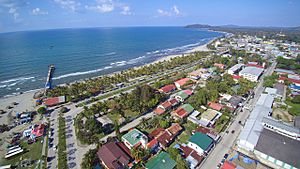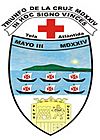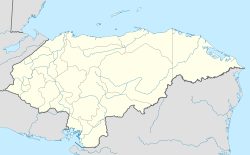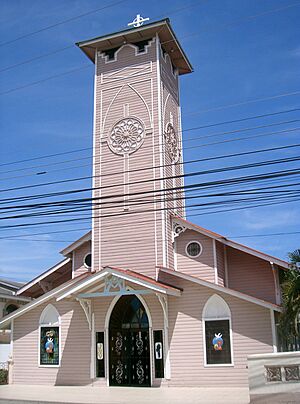Tela facts for kids
Quick facts for kids
Tela
|
||
|---|---|---|
|
Municipality
|
||
| Triunfo de la Cruz | ||

Town of Tela in 2017
|
||
|
||
| Country | Honduras | |
| Department | Atlántida | |
| Foundation | 2 June 1876 | |
| Founded by | Cristobal de Olid | |
| Area | ||
| • Municipality | 1,156 km2 (446 sq mi) | |
| Elevation | 3 m (10 ft) | |
| Population
(2023 projection)
|
||
| • Municipality | 110,255 | |
| • Density | 95.38/km2 (247.02/sq mi) | |
| • Urban | 58,523 | |
| Time zone | UTC-6 (Central America) | |
Tela is a lively town and a municipality in Honduras. It is located on the northern Caribbean coast, in the department of Atlántida. In 2023, about 39,920 people lived in the town itself.
Contents
History of Tela: A Coastal Town's Story
How Tela Began: Early Days
Tela was founded a long time ago by a Spanish explorer named Cristóbal de Olid. This happened on May 3, 1524. He built it near an old town called Tehuacán, which was led by a chief named Cucumba. Tehuacán had fresh water, food, and special plants for medicine.
Olid named his new town Triunfo de la Cruz, which means "Triumph of the Cross." He chose this name because it was a Catholic holy day. Even today, a small point in the bay is still called Triunfo de la Cruz. Some historians think the name Tela comes from the word Tetela. In the Nahuatl language, this means "land of hills and rocky mountains."
Tela was part of the Western Caribbean Zone. This meant it was connected to other places in the Caribbean. English privateers and pirates often visited the area. Also, local groups of people lived and traveled freely here. By the late 1500s, Tela Bay was a popular spot for pirates. They looked for Spanish ships carrying gold and jewels from ports like Trujillo and Puerto Cortés.
Garifuna People Settle in Tela
In 1797, the English sent the Garifuna to Roatan island. The Garifuna are a group of people with African and Caribbean roots. They had been living on St. Vincent. Later, they moved to Trujillo and then along the coast. In 1808, they settled in Tela and started their own communities. One community was Triunfo de la Cruz, and another was San Juan.
Tela in Modern Honduras: Growing as a City
In 1825, Tela was part of the Yoro department. In 1876, it officially became a municipality. Later, in 1893, it moved to the Cortés department. But in 1894, it went back to Yoro. Finally, in 1902, Tela became part of the Atlántida department. Tela officially became a city in March 1927.
From the 1880s to the mid-1900s, Tela's economy focused on growing bananas. By 1912, the government offered help to people who wanted to grow the local economy. This started a "golden age" for banana production in Honduras.
Tela and the United Fruit Company
Tela became a very important port in 1914. It was the main office for the Tela Railroad Company. This company was part of the United Fruit Company. They stayed in Tela until 1970. The company brought many workers to build railroads and work in the banana fields. Many of these workers came from the English-speaking Caribbean, like Jamaica and Belize. They brought the English language and Protestant churches to Tela.
The United Fruit Company built a new town called Tela Nueva for its employees. This town was carefully planned. The best houses were in the "White Zone," where only European-American employees lived. Other workers lived in different areas. The new town had a good hospital, schools, and even a golf course. Some of these buildings are still part of a hotel today.
Local workers who spoke Spanish sometimes felt upset. They thought the English-speaking workers from the Caribbean got the best jobs. The Honduran government later made laws that made it harder for non-Hondurans to live or work there. Between 1930 and 1939, many Caribbean people were sent away. This caused the English-speaking population in Tela to shrink.
In 1930, big floods damaged the banana industry. Bridges broke, and railroads closed. This caused many banana farms to stop working. Tela faced a tough time after this disaster, but it slowly got better.
Mid-20th Century Changes
Tela was a key place during the 1954 General Strike. This strike started with workers who wanted better conditions. It quickly spread across northern Honduras. After the strike, workers gained important rights. Many English-speaking Caribbean workers left the area. They often moved to the United States, Canada, or back to their home countries.
Tela's long dock burned down in 1994. A new one was built quickly in 1995 but collapsed due to strong winds. The part that remains is now used for fishing.
Tela used to have a large railyard. Trains went all the way to the dock. Today, passenger trains still run twice a week from Tela to Puerto Cortés. These are the only train routes still running in Honduras.
Garifuna Villages Near Tela
Tela is one of several towns on the Caribbean Coast of Central America with many Garifuna communities nearby. If you go east along the beach from Tela, you will find Ensenada. Beyond that is Triunfo de la Cruz. To the west along the beach, you will find San Juan, which is very close to Tela. Further west are Tornabé and then Miami.
Culture and Fun in Tela
Tela's special saint is San Antonio. Every June, the town has a big festival to honor San Antonio. There are parades and parties all week long.
Tela is a very popular beach spot for people in Honduras. Many thousands of Hondurans visit during Holy Week. This is the week between Palm Sunday and Easter. They come to party, relax on the beach, and swim in the Caribbean Sea.
Most people in Tela are Catholic. The main Catholic church is Iglesia San Antonio, located across the river from downtown Tela. There are also many other churches in town. These include the Holy Spirit Episcopal Church, a LDS Church, and a large Evangelical church near the beach.
Life in Tela: Infrastructure and Services
Downtown Tela has paved roads. Many areas outside the center have paved main roads, but smaller side streets are often dirt roads.
Most buildings in and around Tela have running water, flush toilets, and electricity. However, some smaller villages nearby do not have these services. Some homes there are made of bamboo or thatch.
Downtown Tela's main street is a busy area for businesses. You can find a well-stocked grocery store, department stores, hardware stores, and many restaurants. There are also internet cafes, banks, and hotels. You can find doctors, dentists, lawyers, and vets. The town also has a small lumberyard.
Two blocks from the town park, there is a large market. It sells fresh vegetables, fruits, and meat every day from nearby farms. Fishermen also bring fresh fish to the market and to many restaurants.
Besides the downtown grocery store and market, almost every street corner in the neighborhoods has a "pulpería." This is a small shop in the front of a family house. It sells milk, eggs, juice, beans, and other daily needs to the neighborhood.
Tela has a public school and at least six smaller private schools. Three of these private schools are bilingual, teaching both English and Spanish.
Climate in Tela: Tropical Weather
Tela has a tropical rainforest climate. This type of climate is usually found near the equator. It means there is no dry season, and it rains throughout the year.
| Climate data for Tela | |||||||||||||
|---|---|---|---|---|---|---|---|---|---|---|---|---|---|
| Month | Jan | Feb | Mar | Apr | May | Jun | Jul | Aug | Sep | Oct | Nov | Dec | Year |
| Record high °C (°F) | 30.3 (86.5) |
31.5 (88.7) |
33.8 (92.8) |
34.6 (94.3) |
34.0 (93.2) |
33.7 (92.7) |
32.8 (91.0) |
32.8 (91.0) |
33.2 (91.8) |
32.4 (90.3) |
31.4 (88.5) |
30.7 (87.3) |
34.6 (94.3) |
| Mean daily maximum °C (°F) | 27.5 (81.5) |
28.1 (82.6) |
29.7 (85.5) |
30.6 (87.1) |
32.1 (89.8) |
31.8 (89.2) |
31.3 (88.3) |
31.3 (88.3) |
31.2 (88.2) |
29.8 (85.6) |
28.8 (83.8) |
27.5 (81.5) |
30.0 (86.0) |
| Daily mean °C (°F) | 23.9 (75.0) |
24.5 (76.1) |
26.0 (78.8) |
27.2 (81.0) |
28.1 (82.6) |
28.2 (82.8) |
27.8 (82.0) |
27.8 (82.0) |
27.6 (81.7) |
26.3 (79.3) |
25.0 (77.0) |
24.3 (75.7) |
26.4 (79.5) |
| Mean daily minimum °C (°F) | 19.5 (67.1) |
19.6 (67.3) |
20.5 (68.9) |
21.8 (71.2) |
23.1 (73.6) |
23.3 (73.9) |
22.7 (72.9) |
22.9 (73.2) |
22.9 (73.2) |
22.1 (71.8) |
21.1 (70.0) |
20.1 (68.2) |
21.6 (70.9) |
| Record low °C (°F) | 16.0 (60.8) |
15.8 (60.4) |
16.9 (62.4) |
18.2 (64.8) |
19.8 (67.6) |
21.4 (70.5) |
20.5 (68.9) |
21.1 (70.0) |
21.4 (70.5) |
19.5 (67.1) |
17.9 (64.2) |
16.5 (61.7) |
15.8 (60.4) |
| Average precipitation mm (inches) | 268.3 (10.56) |
217.8 (8.57) |
122.0 (4.80) |
88.3 (3.48) |
79.9 (3.15) |
148.2 (5.83) |
202.8 (7.98) |
228.4 (8.99) |
247.4 (9.74) |
388.7 (15.30) |
411.6 (16.20) |
421.0 (16.57) |
2,824.4 (111.20) |
| Average precipitation days (≥ 1.0 mm) | 12 | 8 | 5 | 4 | 5 | 9 | 12 | 13 | 12 | 14 | 13 | 13 | 120 |
| Source: NOAA | |||||||||||||
See also
 In Spanish: Tela (Honduras) para niños
In Spanish: Tela (Honduras) para niños







